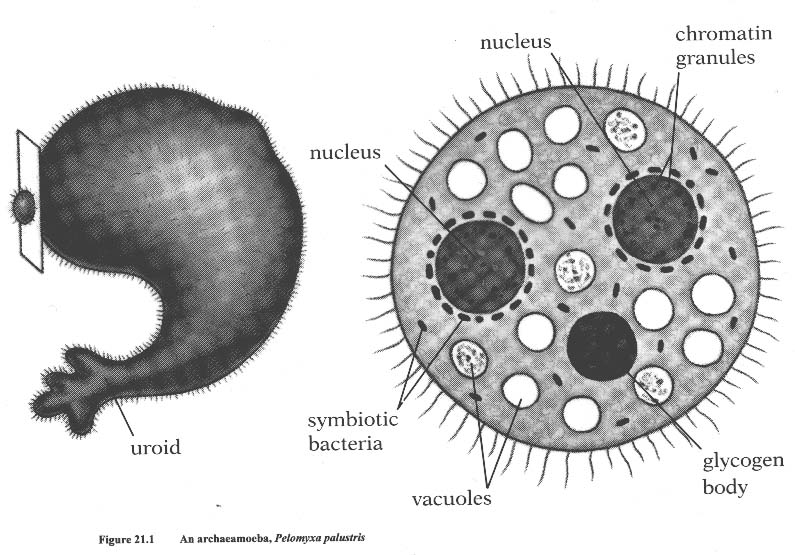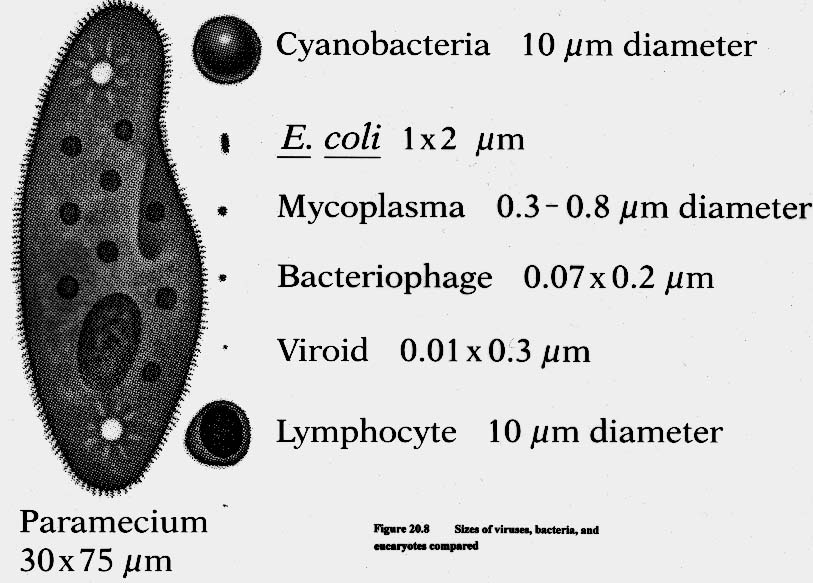
I. Prokaryotes vs eukaryote cells
| Prokaryotes | Eukaryotes (true nucleus) | |
| Genetic package | circular without proteins | chromosomes with histones |
| Replication | binary division | mitosis |
| Sex | conjugation, transduction, transformation | meiosis |
| Organelles | ribosomes | ribosomes, ER, Golgi, mitochondria, chloroplasts |
| Metabolism | heterotrophs, several chemoautotrophs | heterotrophs, one type of photosynthesis |
| Respiration | aerobic, anaerobic | aerobic |
| Cell size | less than 1 µ usually | more than 10 µ usually |
| Cell shape | peptidoglycan cell wall | plasma membrane or cellulose wall |
| Cell movement | simple flagella | 9+2 microtubule flagellum |

II. Organelle evolution by endosymbiosis - ancestral eukaryote coopted bacterial
assistants
A. Mitochondria - resemble aerobic bacteria
1. circular ds DNA, complete set of tRNA and ribsome genes
2. nucleus cannot create mitochondria, but use nuclear enzymes to replicate DNA
3. ribosomes are small like bacteria
4. produce energy (ATP) for the cell
5. all eukaryotes have very similar mitochondria genomes with same genes, in animals, genome is almost always 16 kilobases in size
6. only permit maternal inheritance, don't have sex
7. a cell with mitochondria could invade an oxygen rich atmosphere, which is otherwise harmful because it oxidizes molecules
B. Chloroplasts - resemble photoautotrophic bacteria
1. bacteria and chloroplasts are susceptible to same antibiotics
2. circular ds DNA, complete set of tRNA and ribsome genes
3. multiple types of chloroplasts, suggest recurrent acquisition
4. a cell with chloroplasts can fix carbon from CO2 and gives off oxygen

C. Bacterial endosymbiosis?
1. Plasmids are circular DNA molecules that resemble DNA phage without protein coats
2. Plasmids cause conjugation
3. Plasmids also carry useful genes and can transfer them to other cells
III Kingdom Archaezoa (3 phyla, none have mitochondria)
1. Archaeamoebae - Pelomyxa uses three species of symbiotic methanogenic bacteria as endosymbionts

2. Metamonada - Giardia
3. Microsporidia - parasitic, most infect fat of invertebrates by spores
IV Kingdom Protista, Subkingdom Kinetoplastids
A. Phylum Euglenozoa - discoidal mitochondrial walls
B. Subphylum Kinetoplasta
1. 1-1000 flagella, unicellular
2. symbiotic forms in termites
3. include trypanosomes
a. cause sleeping sickness vectored by tsetse fly, other vertebrates can be hosts
b. cause Chagas' disease (killed Darwin) - vectored by bugs
c. evade immune system by continually changing cell-surface proteins
C. Subphylum Euglenoida
1. like animals and plants - some have mitochondria and chloroplasts
2. may have developed by a heterotrophic euglenoid eating green algae
3. undergo mitosis, never been observed having sex
D. Phylum Amoebozoa: Amoeba - move by extending pseudopods (false-foot)
E. Phylum Reticulosa: Foraminifera - calcareous tests, create limestone cliffs
V Kingdom Protista, Subkingdom Alveolata - alveolar sacs in cells
A. Phylum Ciliophora
1. includes Paramecium, Stentor, etc, covered with hair-like projections (cilia)
2. have macro (860-ploid) and micronucleus
3. meiosis occurs during conjugation
a. macronucleus dissolves, and one haploid micronucleus survives
b. haploid micronucleus is duplicated and exchanged
c. fusion occurs, macronucleus is recreated after polyploidy
d. Why does the macronucleus dissolve?

B. Phylum Dinoflagellata
1. planktonic, single cells with 2 flagella, many are photosynthetic
2. symbiotic, zooxanthellae in corals
3. some produce luminescence, which you can see in boat wakes or in wave crests
4. can cause red tides which can produce toxins that can be harmful if ingested in shellfish
5. cyst stage has cell wall made of cellulose
6. Pfisteria also produce toxins and cause huge fish kills here and in Virginia, N Carolina
a. Pfisteria outbreaks occur after nitrate and phosphorus pollution, e.g. hog or chicken manure gets washed into the water
b. Pfisteria actively seeks out human blood and consumes flesh
c. Pfisteria toxin can cause short-term memory loss and ulcerated sores
C. Phylum Apicomplexa
1. most are parasitic with complex life cycle, i.e. alternation of hosts
2. spore stage has cell wall made of cellulose
3. includes Malaria causing Plasmodium
4. Plasmodium life cycle

VI. Kingdom Protista, Subkingdom Mycetozoa - slime molds
1. true slime molds
a. haplo-diploid life cycles with diploid amoebae stage
b. and multinuclear diploid mycelium stage
c. undergo sex under poor environmental conditions

2. cellular slime molds, e.g. Dictyostelium discoidum
a. normally unicellular haploid amoeba, but form slugs when food supply decreases
b. slug makes fruiting body with spores, which can either
i. encyst if envt is bad
ii. return to being haploid amoebae
iii. fuse to become diploid cells that aggregate and then undergo meiosis
c. model for cell-cell signalling in development, use cAMP
d. why do the cells cooperate to build fruiting body if they don't become spores?
